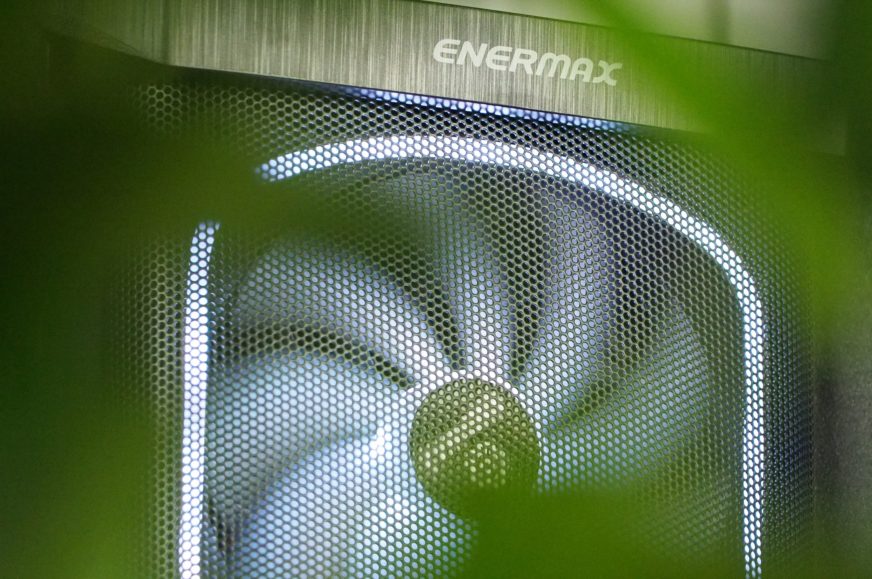Interior
Enermax’s latest case strikes a fairly good balance between visual and functional features. The more intense ARGB LED lighting is complemented by as many as four fans. Combined with a decently perforated front panel, the airflow is “taken care of”. On the other hand, there are a few things to complain about in this price range. What is attractive and what is not about the StarryKnight SK30 midi-tower?
Interior
The spacious interior of the case is also suitable for E-ATX motherboards with a width of 330 mm. The remaining formats such as ATX, mATX and Mini-ITX are standard in the midi-tower class. There’s plenty of room for tower CPU coolers too. Up to a height of 170 mm, you won’t be limited with your choice, so there are plenty to choose from. You have just as much space when fitting a graphics card, which can be up to 405 mm long. This makes the case ready for the next generation of graphics cards, which are getting bigger all the time.
For graphics cards longer than 230 mm, a support on the tray is also available. Thanks to the possibility to adjust its height vertically and a joint ensuring horizontal movement, you can precisely adjust its position under the graphics card. The contact surface is rubberised for gentle support of the card.
None of the openings in the case are fitted with a rubberized grommet for a more cohesive interior appearance. Fortunately, they are ground down and have no sharp edges. The width of the vertical and horizontal holes differ. The vertical ones are 30 mm wide while the horizontal ones are 25 mm wide. Larger widths are good for easier threading of thicker cable bundles.
Two positions for 120 mm fans are located on the ceiling of the tunnel. These are also there thanks to the perforation through which air can be drawn into the fans. Just next to the tray there are three identical holes for cables as there are under the ceiling of the case. Their width is sufficient to allow you to comfortably handle the cables even just below the board. Although not the last, the all the more important tunnel opening is located at the front of the case. This one serves for a liquid cooler radiator with a depth of 65 mm, which can be already tight for the thicker ones. The last hole is in front of the power supply and thanks to it you can look through the tempered glass to see the PSU as well.
From the other side of the tray, you get to the more challenging part of the interior, especially when it comes to cable management. For organizing, you have 21 mm of space from the tray to the side panel. The main bundle of cables is pulled between the four vertical openings, which it also fastens against. You have additional fixing options completely in front, behind the panel and around the perimeter of the motherboard opening. In total, you have the option of attaching cables in 16 different positions.
All four fans have two power connectors. One is a 3-pin and the other is a 4-pin Molex. The latter can be daisy chained together, which can be an advantage on boards with fewer PWM headers.
There’s a controller for the fan lighting, and you can plug up to six devices into it. It is powered directly from the power supply by a SATA cable. You can control the lighting in two ways. Either through the motherboard with the ARGB connector plugged in or with the restart button on the case. With the latter, you have thirteen programmed lighting modes available directly in the controller.
Behind the motherboard, there are also two positions for 2.5″ storage. You remove the brackets from the tray, use the four screws on the side to secure the storage and hang it back into the case. This method of mounting allows for quick and easy handling of the storage even when the case is already fitted with other components.
In the tunnel, there is only a smaller drawer with a pair of hybrid positions for 3.5 or 2.5″ storage. One installs directly on top of its structure and the other into a bracket within it. There is 220 mm of space for the power supply with cables from the drawer to the end of the case. When the drawer is removed, you get an extra 180 mm. You won’t have much reason to pull the drawer out though. With its low height, you can also handle the cabling directly above it.
The installation was relatively easy except for the cable management. There are two connectors on the fan’s power cable, first a Molex with a 5V connection and then a 3-pin. The distance between the two is short, so it was more difficult to fit and hide the Molex connector into the cable management while the 3-pin is connected in the motherboard. Two zip ties from the accessories will be enough for securing and then closing the side panel.
The holes for cabling are large enough to avoid difficulties during routing. Even the hardware itself was easy to fit thanks to the large space inside the case.
Everything is held together by 0.7 mm thick metal sheets, but their stiffness is not quite ideal and they bend slightly even with a light pressure.
- Contents
- Exterior
- Interior
- Test methodology
- CPU and GPU cooling tests
- Motherboard cooling tests
- SSD cooling tests and under-ceiling temperature
- Conclusion





























